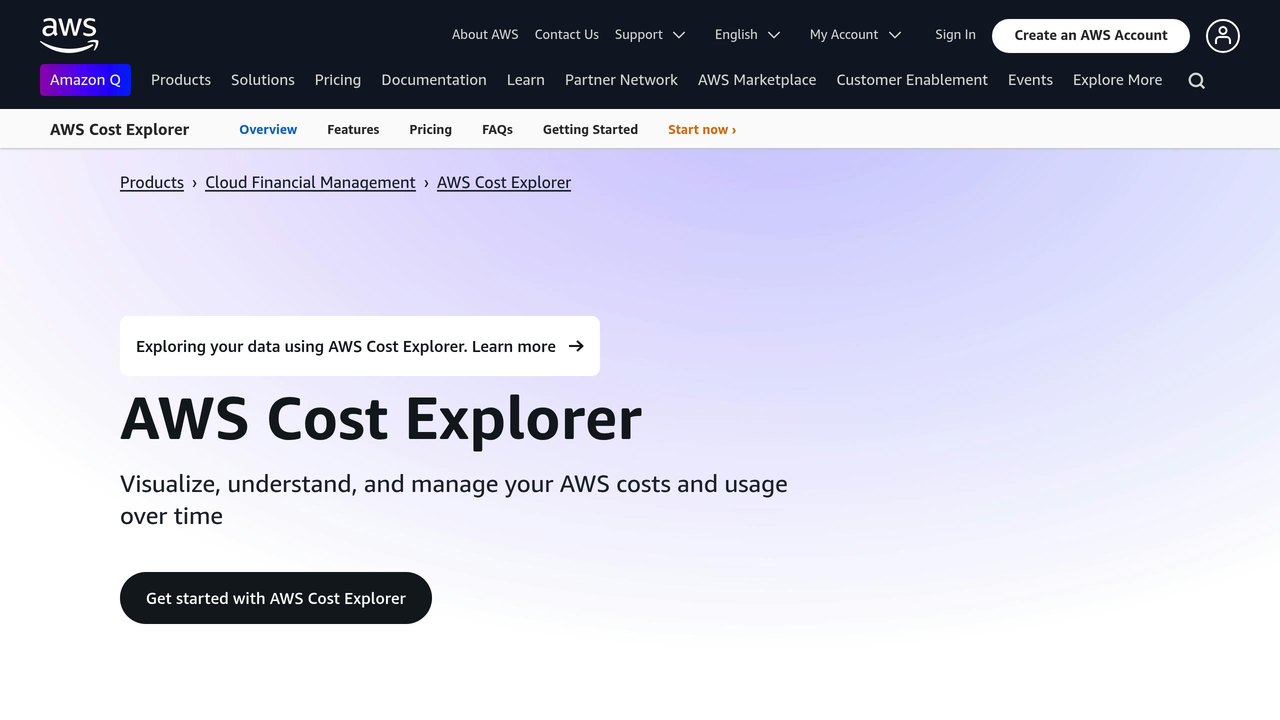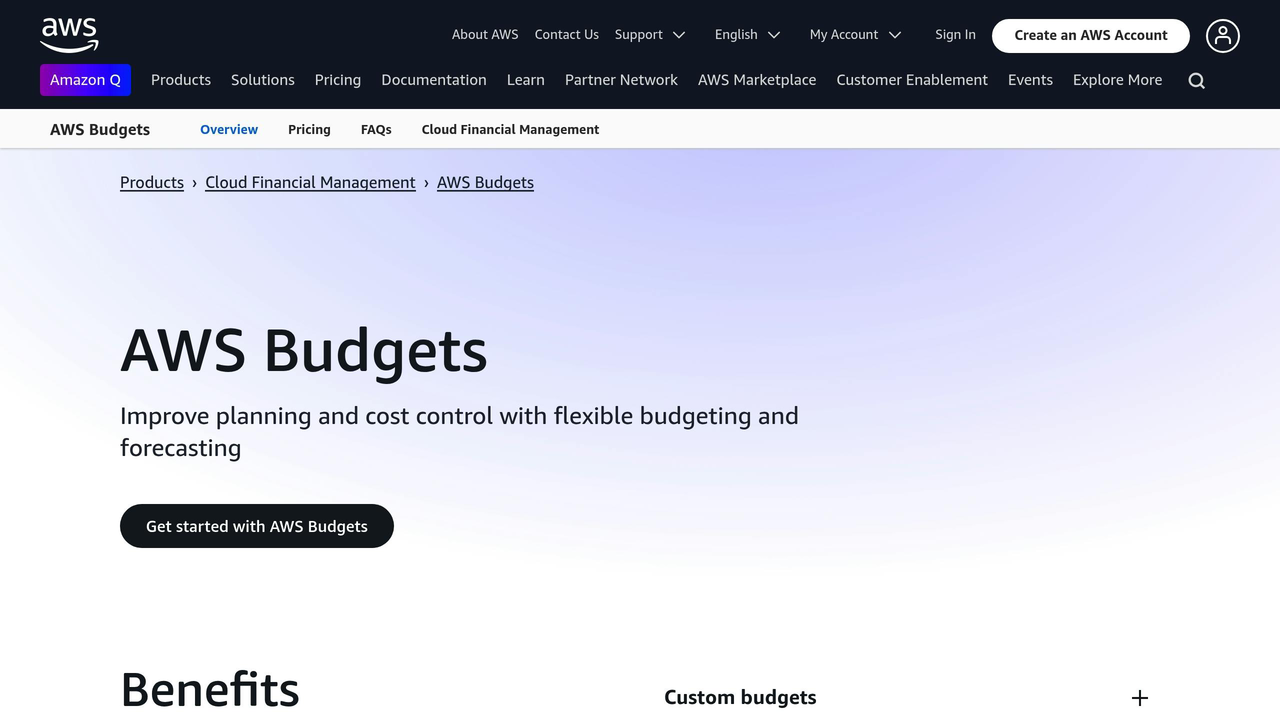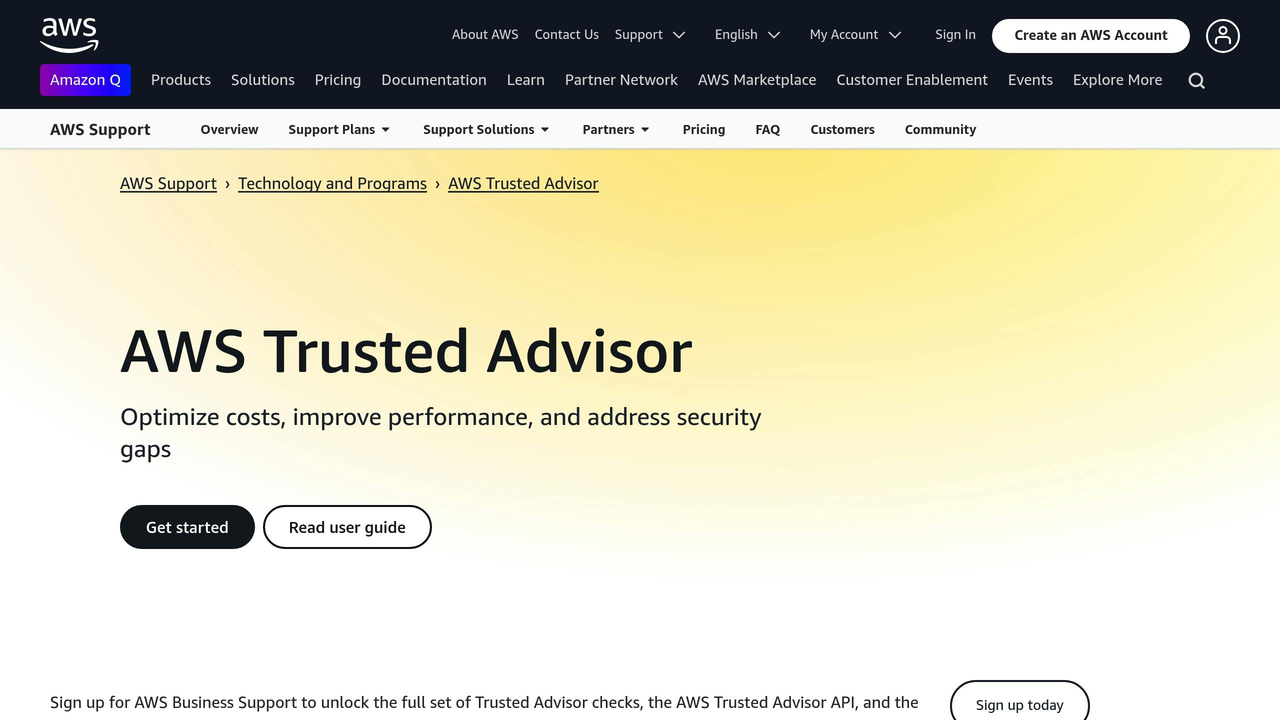Built-in AWS tools for cost analysis and optimization

Cloud spending is expected to reach $723 billion by 2025, and 94% of companies overspend on cloud services. AWS provides built-in tools to help you analyze and optimize your costs. Here’s what you need to know:
Key AWS Cost Management Tools:
AWS Cost Explorer: Tracks and visualizes costs with tools like forecasting, resource-level analysis, and custom reports.
AWS Budgets: Lets you set spending limits, receive alerts, and automate actions to stay within budget.
AWS Trusted Advisor: Offers cost-saving recommendations like rightsizing resources and eliminating idle instances.
Quick Benefits:
Use Cost Explorer to spot trends and forecast expenses.
Set Budgets to monitor spending and avoid surprises.
Apply Trusted Advisor tips to cut waste and optimize resources.
Quick Comparison:
| Tool | Purpose | Key Feature | Example Use Case |
| Cost Explorer | Analyze and visualize costs | Forecasting and custom reports | Track spending trends by department |
| AWS Budgets | Set spending limits and alerts | Automated actions and notifications | Avoid overspending with alerts at 80% of budget |
| Trusted Advisor | Get cost-saving recommendations | Idle resource checks | Terminate unused EC2 instances |
These tools work best when used together. For example, Cost Explorer helps you identify high-cost areas, while Trusted Advisor suggests how to optimize them. Pair this with Budgets to stay proactive about cost control.
Start using these tools today to avoid overspending and maximize the value of your AWS investment.
Choosing the right tools to optimize AWS costs | AWS Events
AWS Cost Explorer: Track and Analyze Spending

AWS Cost Explorer is your go-to tool for breaking down and understanding your AWS costs. Here's how you can make the most of its features.
Main Functions and Applications
Cost Explorer shines with its ability to provide clear and detailed visualizations of your AWS spending. It gives you access to 38 months of historical data at a monthly level [2], making it easier to identify trends over time. For more recent activity, you can dive into hourly data for the last 14 days [2], which is perfect for spotting sudden usage spikes or areas to optimize.
Here’s a quick look at some of its standout features:
| Feature | Purpose | Business Impact |
| Cost Forecasting | Predicts future spending using past trends | Helps you plan budgets and avoid surprises |
| Resource-Level Analysis | Tracks costs at the individual resource level | Pinpoints specific areas driving up expenses |
| Custom Reports | Tailors views with filters like tags or accounts | Makes cost optimization more focused and actionable |
| API Integration | Allows programmatic access to cost data | Automates workflows for better cost management |
These tools are more than just numbers - they help businesses make smarter, faster decisions about their AWS usage. Take Wildlife Studios, for example: by using Cost Explorer to break down costs by business unit, they gained a clearer understanding of departmental spending, which helped them manage budgets more effectively.
Using AWS Cost Explorer Effectively
To unlock the full potential of AWS Cost Explorer, keep these strategies in mind:
1. Set Up Custom Views
Tailor your reports to match your company’s structure. Use filters like tags, services, or accounts to track spending by department, project, or team. This lets you see exactly where your money is going.
2. Leverage Forecasting
Cost Explorer updates cost data at least once every 24 hours [3], so you’ll always have fresh insights. Use its forecasting tools to:
Predict future costs based on historical trends.
Spot potential budget overruns before they happen.
Adjust capacity and spending plans in advance.
3. Implement Resource-Level Tracking
Drill down to individual resource costs, especially for high-usage services like EC2. For instance, Duda Inc. uses the Cost Explorer API to track unusual usage patterns, helping them allocate resources more efficiently. To get the most out of the API:
Use caching to reduce the load on queries.
Apply specific filters to speed up response times and simplify data processing [4].
Cost Explorer also offers 3 months of daily forecasts and 12 months of monthly forecasts [4], giving you the tools to plan both short-term and long-term budgets.
AWS Budgets: Set Spending Limits and Alerts

AWS Budgets updates your cost information up to three times a day, making it easier to stay on top of your spending [5]. Let’s dive into how you can use these tools to set up effective budget controls.
Creating Budget Controls
AWS Budgets offers three main budget types, each tailored to specific needs:
| Budget Type | Purpose | Key Benefits |
| Cost Budgets | Track overall AWS spending | Helps you avoid overspending with fixed or adjustable spending targets |
| Usage Budgets | Monitor service consumption | Keeps service usage within limits, including staying inside the Free Tier |
| RI/Savings Plans | Track utilization and coverage | Ensures you’re getting the most out of your reserved or committed resources |
Each AWS account includes two free budgets to get you started [6].
Fixed vs. Variable Targets
You can set budgets as fixed amounts or make them flexible with variable targets. For example, you might choose to increase your budget by 5% each month to account for planned growth [5].
Scope and Filtering
AWS Budgets allows you to track specific cost categories, such as:
Blended or unblended costs
Net amortized expenses
Support fees and taxes
Discounts and refunds
This flexibility ensures your budgets are tailored to your needs.
Budget Alert Configuration
Alerts are a key tool to avoid unexpected expenses. AWS Budgets enables you to set notifications based on both actual spending and forecasted costs [5]. For instance, setting an alert at 80% of your budget allows you to take action before hitting your limit. You can send these alerts to up to 10 email recipients [8].
Automated Actions
AWS Budgets also supports automated actions to help you manage spending more effectively:
Policy Enforcement: Use IAM policies to restrict resource provisioning when spending approaches your limits [5].
Resource Management: Automate actions targeting specific resources, like EC2 or RDS instances, when spending exceeds thresholds [7].
Notification Integration: Deliver alerts through email, Amazon SNS topics, or even Amazon Q Developer chat apps [7].
Because billing cycles can sometimes delay updates, it’s a good idea to set conservative thresholds. This gives you enough time to take action and stay aligned with your cloud spending strategy [5].
AWS Trusted Advisor: Get Cost-Saving Tips

AWS Trusted Advisor takes your cost management efforts a step further by offering practical recommendations to help you save money. Acting as an automated consultant, it scans your AWS setup using 28 optimization checks to identify areas where you can cut costs [9].
Cost-Saving Opportunities
Trusted Advisor reviews your AWS environment to uncover savings in critical areas:
| Check Category | What It Analyzes | Potential Benefits |
| Idle Resources | Unused EC2 instances, underutilized EBS volumes | Reduce costs instantly by terminating unnecessary resources. |
| Capacity Planning | Reserved Instance opportunities, instance sizing | Save long-term by optimizing resource allocations. |
| Service Usage | Load balancers, IP addresses, redundant services | Lower monthly expenses through service consolidation. |
It also provides an estimate of your potential monthly savings, though actual results depend on your specific configurations.
Applying Advisor Recommendations
Focus on 'Action recommended' (red) items first for the biggest savings. The Trusted Advisor console offers clear, step-by-step instructions to help you act quickly.
Implement changes one by one, refreshing the results after each step. This ensures accurate savings calculations and keeps your data up to date.
If you're on a Business, Enterprise On-Ramp, or Enterprise Support plan, Trusted Advisor updates its checks weekly. Set up email notifications to stay on top of new savings opportunities and track your progress.
Leverage AWS resource tags to filter Trusted Advisor checks. This makes it easier to focus on specific projects or environments, helping you streamline your cost-cutting efforts.
For added insight, download the check results periodically. This allows for offline analysis and reporting, making it easier to track improvements and refine your cost-saving strategies over time.
Combining AWS Cost Tools Effectively
Tool Integration Methods
AWS offers a suite of cost management tools, and their real power lies in how you combine them. AWS Cost Explorer helps you dive into spending trends, AWS Budgets lets you set spending limits and stay proactive, and AWS Trusted Advisor provides actionable tips for trimming costs. Together, they create a robust system for managing expenses. Here's a quick breakdown of how these tools work together:
| Tool Combination | Primary Function | Integration Benefit |
| Cost Explorer + Budgets | Cost Tracking | Use Cost Explorer's historical data to set realistic and achievable budget limits. |
| Budgets + Trusted Advisor | Cost Control | Leverage Trusted Advisor insights to stick to your pre-set budget thresholds. |
| Cost Explorer + Trusted Advisor | Resource Optimization | Spot areas for savings by analyzing usage patterns and applying recommendations. |
Here’s how you can make the most of these tools:
Enable Enhanced Monitoring: Turn on hourly and resource-level granularity in Cost Explorer. This gives you a clearer picture of where your money is going and how your resources are being used.
Implement Automated Controls: Use AWS Cost Anomaly Detection to catch unusual spending patterns early. Pair this with AWS Budgets for alerts that keep you ahead of potential cost overruns.
Establish an Optimization Workflow: Start with Cost Explorer to identify high-cost areas, then cross-check those findings with Trusted Advisor's suggestions to take targeted actions.
Cost Management Best Practices
Once you've integrated these tools, it's essential to follow consistent practices to keep your costs in check and maintain efficiency. The AWS Cost Optimization Hub is a great resource for staying on track. Here are some key strategies to adopt:
1) Regular Resource Assessment
- Check for idle or underutilized EC2 instances using Cost Explorer.
- Analyze storage usage patterns to avoid paying for unused capacity.
- Review Reserved Instance coverage to ensure you're getting the most out of your commitments.
2) Automated Cost Controls
- Set up tiered budget alerts (e.g., at 50%, 75%, and 90% of your budget).
- Configure email notifications to stay informed of any budget breaches.
- Use anomaly detection to catch unexpected cost spikes before they escalate.
- Enable AWS Compute Optimizer for automatic rightsizing suggestions.
- Regularly review rightsizing recommendations in Cost Explorer.
- Act quickly on Trusted Advisor recommendations to avoid unnecessary expenses.
- Dive into service-specific metrics in Cost Explorer for a granular view of your spending.
Summary: AWS Cost Management Tools
AWS provides a suite of cost management tools designed to help businesses keep cloud spending under control. With 94% of companies overspending on cloud services [1], these tools are essential for maintaining financial efficiency and avoiding unnecessary expenses.
AWS Cost Explorer offers detailed insights into your spending, making it easier to spot trends and anomalies. Paired with AWS Budgets, which allows you to set spending limits and receive alerts, these tools put you in the driver’s seat when it comes to managing costs. Additionally, AWS Trusted Advisor scans your setup for potential savings, identifying idle resources and recommending optimizations.
Here’s a closer look at what each tool brings to the table:
| Tool | Primary Function | Key Benefit | Impact |
| Cost Explorer | Detailed cost analysis and reporting | Highlights spending patterns and anomalies | Supports smarter, data-driven decisions |
| AWS Budgets | Budget enforcement and alerting | Helps avoid unexpected cost overruns | Keeps spending aligned with your plan |
| Trusted Advisor | Optimization recommendations | Pinpoints waste and cost-saving opportunities | Improves efficiency and reduces waste |
To get the most out of these tools, consistent monitoring and action are key. Dive into Cost Explorer reports regularly to identify trends, set up alerts in AWS Budgets to stay ahead of potential overspending, and apply Trusted Advisor recommendations to eliminate waste. Together, these tools provide a solid foundation for managing costs and maximizing the value of your AWS investment [1].
FAQs
How does AWS Cost Explorer help businesses predict and control cloud expenses?
AWS Cost Explorer is a handy tool that helps businesses understand and predict their cloud expenses by analyzing both past and present cost and usage data. This makes it easier to spot spending patterns, estimate future costs, and plan budgets with confidence.
Its user-friendly interface lets you build custom reports, filter data by specific services or time frames, and even set spending limits to avoid surprise charges. Using these insights, you can better align your cloud usage with your business objectives and manage your AWS budget more efficiently.
What’s the difference between AWS Budgets and AWS Cost Explorer, and how can they work together to manage costs effectively?
When it comes to managing AWS costs, AWS Budgets and AWS Cost Explorer are two essential tools, each with its own focus.
AWS Budgets is all about staying ahead of your spending. It lets you set custom spending limits and sends alerts whenever your costs start nearing - or exceed - those limits. This makes it perfect for keeping your expenses in check and ensuring they stay within your planned budget.
On the flip side, AWS Cost Explorer dives into the details of your historical AWS spending. It offers detailed breakdowns, visual reports, and insights to help you spot trends and uncover ways to optimize your costs.
By combining these tools, you can take a proactive and analytical approach to cloud cost management. Use AWS Budgets to set financial targets and rely on AWS Cost Explorer to track and analyze how your actual spending measures up. Together, they help ensure your cloud expenses align with your business goals.
How does AWS Trusted Advisor help reduce costs, and what steps can I take to apply its recommendations?
AWS Trusted Advisor is a handy tool for trimming down your AWS expenses. It reviews your AWS setup, spots resources that aren’t being fully utilized, and offers tips to make your spending more efficient - all based on AWS best practices.
To make the most of its recommendations, begin by checking the Trusted Advisor console. Focus on suggestions that fit your business goals, like scaling down unused resources or moving to more budget-friendly pricing plans. By acting on these insights, you can streamline your AWS costs while boosting overall efficiency.
